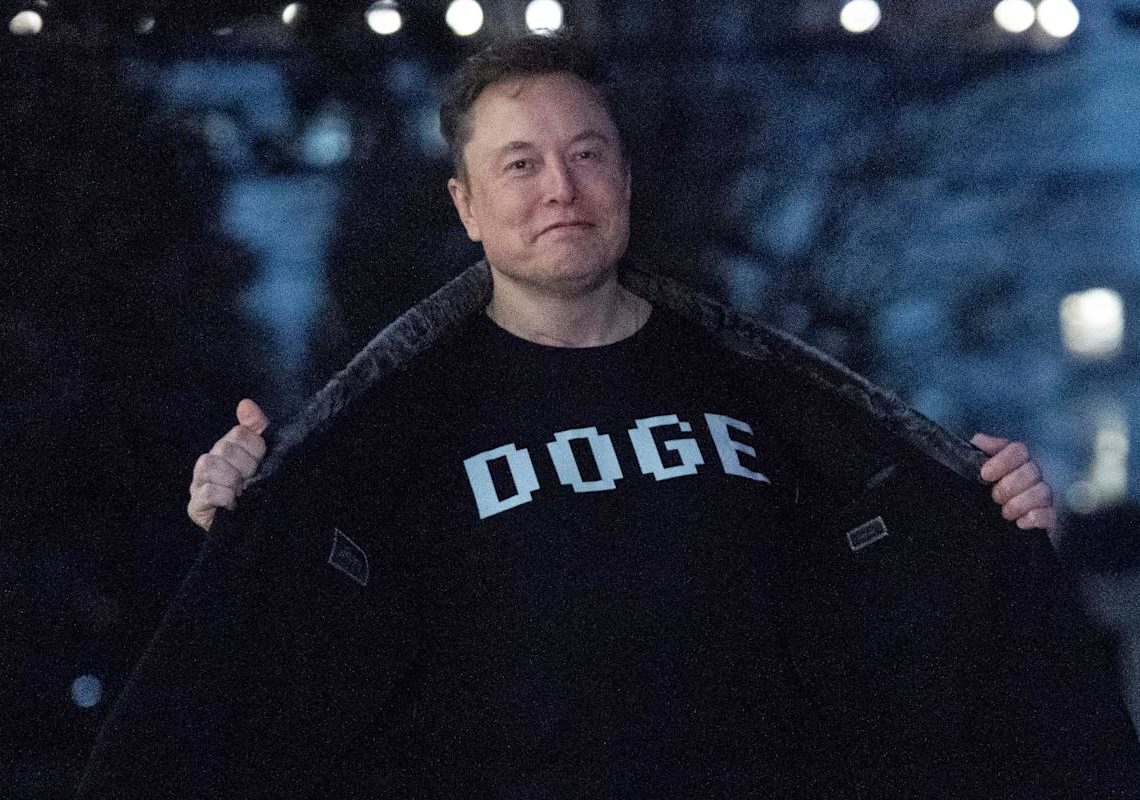Elon Musk had to publicly pitch Donald Trump on a government cost-cutting initiative three times at an X Spaces campaign event last August before he appeared receptive.
“We need a government efficiency commission,” said the billionaire, who was spending hundreds of millions of dollars to get Trump elected. The president responded with a tangent on rebuilding the military.
Eight months later, that project has become arguably the most powerful force of the beginning of Trump’s second term. Headed by Musk, named after an internet meme and administered, in large part, by mysterious twentysomething engineers, DOGE in 100 days has reshaped Washington, hobbling its longstanding institutions as the world’s richest man brings a chainsaw to a bureaucracy he claims is rife with “waste, fraud and abuse.”
DOGE has cut a wide swath — shrinking the federal workforce to 1960s levels. But its impact in other ways has been more narrow than both supporters and detractors might realize. Government spending is actually increasing amid all the DOGE cuts, with notable exceptions including foreign aid and education.
“In a sense, it’s more successful than you might have thought, in a sense it’s less,” said an administration official close to DOGE who was granted anonymity to speak freely.
Nearly a quarter of a million workers have or are expected to leave their federal jobs. That includes more than 112,000 federal workers who have opted into the deferred resignation program, according to a POLITICO analysis of previous reporting and conversations with administration officials. It also includes some 121,000 workers across agencies who have been fired, according to a CNN analysis.
DOGE has hollowed out or shut down 11 federal agencies and says it has terminated more than 8,500 contracts and 10,000 grants. It has wiped out foreign aid and volunteerism in the U.S., slashed education spending and made sweeping changes to the way the government makes procurements, hires contractors and shares data.
“In terms of downsizing, it’s unprecedented for sure,” said Richard Stern, a federal budget expert at the conservative Heritage Foundation. He noted that other government makeovers, like the New Deal and Great Society, had been larger — but that DOGE was unique because it is subtractive, not additive.
DOGE, after promising $2 trillion in savings, now says it has saved the government $160 billion. But even these reported savings, so far, have not led to any meaningful decline in total government spending this year, according to the nonpartisan Penn Wharton Budget Model, which tracks weekly Treasury data.
In fact, the government has actually been spending more compared to this time last year, the model found.
Total spending rose by 6.3 percent, or $156 billion since Trump took office, compared to the first four months of 2024, said Kent Smetters, a Wharton professor who directs the model. Even when accounting for inflation, the federal government has still added $81.2 billion more spending to its books compared to the same period last year, he added.
In a statement after publication, White House Principal Deputy Press Secretary Harrison Fields said Trump had a “mandate” to “uproot waste, fraud and abuse.” He added: “This isn’t easy to do in a broken system entrenched in bureaucracy and bloat, but it’s a task long overdue.”
A DOGE spokesperson did not respond to a request for comment.
Inside the DOGE operation
The operation was part planned, part improvised. Musk assembled a core team of around 40 staff even before the inauguration, most with backgrounds in engineering, venture capital or digital infrastructure, not public administration. The first month and a half of 2025 saw aggressive action.
Musk, a “special government employee” who still heads Tesla, SpaceX and X and has billions of dollars in federal contracts, faced almost no internal levers of scrutiny or accountability in those early days. With boundless resources and a direct line to the president, Musk wielded his accumulated power freely, appearing at Cabinet meetings and in the Oval Office alongside Trump.
And armed with the playbook he used to gut Twitter, Musk revved the chainsaw.
The most immediate and heavy-handed cut came at the U.S. Agency for International Development. Backed by strong Republican support and Trump’s promises to nix U.S. spending abroad, DOGE effectively dismantled the agency, sacking about 10,000 staff members and instructing a remaining skeleton crew to shred and burn internal documents.
DOGE also decimated smaller foreign aid agencies, including the U.S. Institute of Peace and the Millennium Challenge Corporation. That’s reflected in the meaningful decline in spending on the U.S. international presence: USAID, the State Department, and other international assistance programs are all down from the late Biden years, adding up to around $2 billion in savings over the first four months of the year, according to the Penn Wharton Budget Model.
Elsewhere, DOGE made sweeping cuts that caught much of Washington off guard. The DOGE engineers relied on Musk’s mantra to cut 20 percent more than you needed and then add back: “If you’re not in pain, then you didn’t cut enough,” Musk is known to say. The “adding back” was constant: Nuclear power workers, those working on bird flu and regulators overseeing medical devices like heart implants were rehired after initial layoffs.
The first Cabinet-level agency to execute its reduction in force was the Education Department, which moved to cut about 1,300 employees — over 30 percent of its workforce. Those cuts led to the second area of actual decline in spending this year.
The Penn model calculates the department’s spending declined by $10 billion in the last year, when accounting for inflation, to levels not seen in about 15 years, according to Smetters.
Musk faces blowback
By March, the blowback was in full force. DOGE became the subject of at least five dozen lawsuits. Congressional Republicans — rocked by viral outbursts at town halls by worried constituents — expressed concern about the impact on veterans and rural health clinics.
National polling showed that Americans are worried about DOGE, and Musk’s favorability is underwater and trails Trump’s. Democrats seized the opportunity, branding Musk as an unelected, oligarchic boogeyman with unchecked power. During a Wisconsin Supreme Court race earlier this month framed as a referendum on Musk, they delivered him a crushing defeat.
In Washington, Musk’s clashes with Cabinet members including Secretary of State Marco Rubio, Transportation Secretary Sean Duffy and Treasury Secretary Scott Bessent became public. Others like Defense Secretary Pete Hegseth expressed their hesitation at deep personnel cuts in private.
Musk’s business fortune was turning, too. His net worth has dropped by more than $100 billion since its peak in December, according to Forbes, as Tesla’s sales and stock price fell rapidly amid boycotts. The billionaire also expressed fear for his personal safety, following a series of attacks on Tesla vehicles that the Justice Department is charging as acts of domestic terrorism.
During a Tesla earnings call last week, after the company announced a stunning 71 percent decrease in net income for the quarter, Musk told shareholders he would step back from his government work to focus on Tesla, dropping his DOGE commitment to “a day or two” per week.
But even as DOGE loses its biggest advocate in Washington, it will continue to operate in a more decentralized model, with smaller teams embedded within agencies to carry out reductions in force and efficiency missions.
Agencies including the Departments of Interior, Commerce and Veterans Affairs are still preparing to conduct reductions in force after offering two rounds of deferred resignations.
But notably, administration officials don’t expect massive layoffs at the Pentagon, the biggest agency that has remained largely untouched. In some cases, departments are holding back approvals for deferred resignation programs to avoid losing critical staff.
DOGE’s legacy
Max Stier, president and CEO of the Partnership for Public Service, a nonpartisan, pro-government nonprofit, said DOGE has touched “every element of our government,” but noted that its impact has been “deeper” in the fields of scientific research and health care, and in international development, which he said has been “wiped away.”
“This is not an on-and-off switch,” Stier said. “What they’ve gotten rid of is important capability, amazing talent and deep relationships, both here and in other places. To rebuild will require not 100 days, but years and years.”
Meanwhile, a core group of DOGE staffers is pushing forward on another major project: building a consolidated immigration and citizenship database to track migrants entering the country and allow government officials to more easily identify and deport them, several officials said. That endeavor, if successful, could reorient federal immigration enforcement for decades.
“Trump’s first term was a failure insofar as the country was a failure under Biden,” a Trump administration official closely aligned with DOGE said. “They didn’t break anything.”
“Are you going to be able to reshape the government in order to be in a position to make it take them time to hire back to advance the deep state?” the person added. “That’s what’s important.”
The post DOGE has made a big impact on Washington. But government spending is up. appeared first on Politico.




